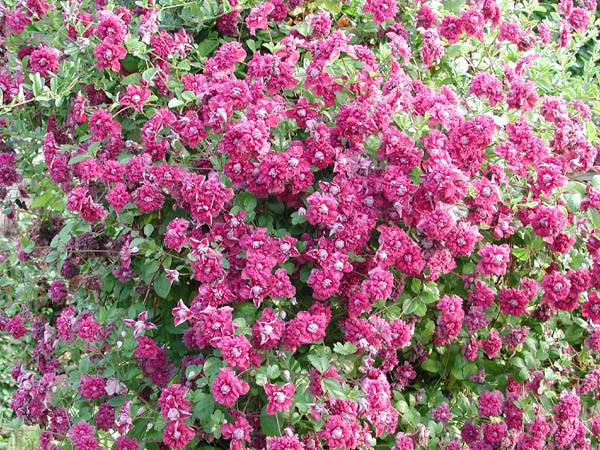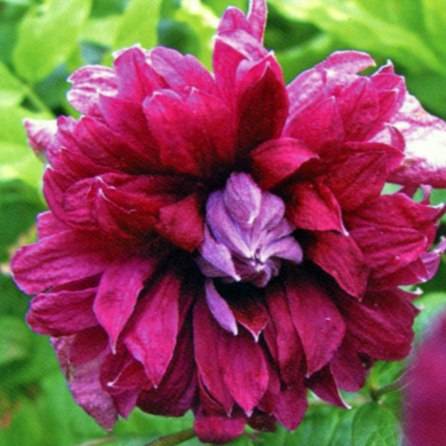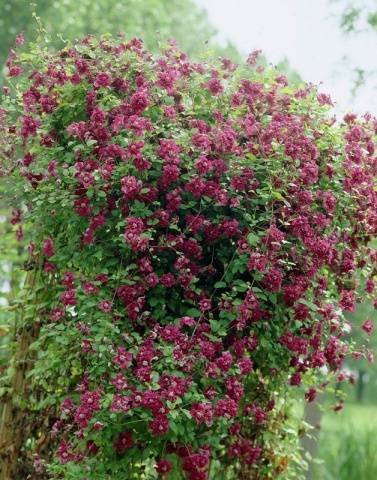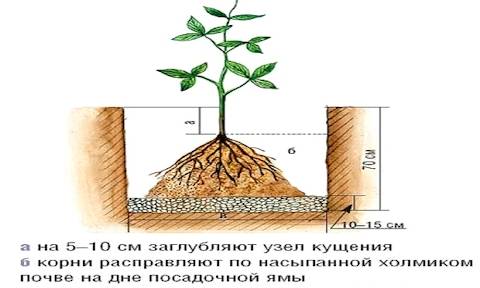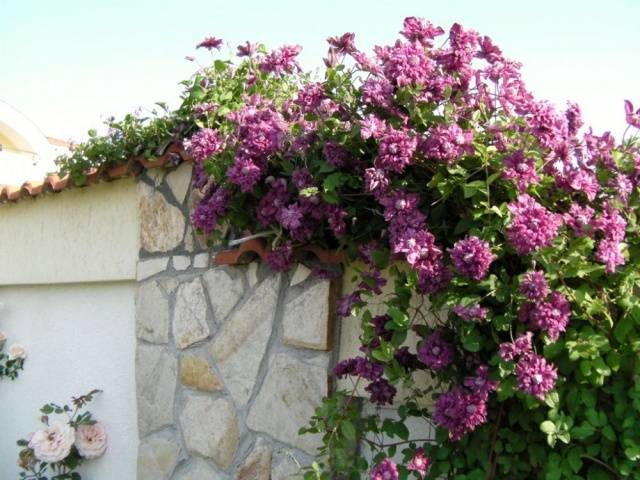Content
Of course, for experienced flower growers or venerable plant collectors, the Clematis Purpurea Plena Elegance variety will not be a discovery, it is too widespread and popular. But on the other hand, beginners in floriculture will not be able to resist admiration for a truly worthy variety of clematis, which simultaneously combines unpretentiousness with the beauty and abundance of flowering.
Description
The variety of clematis Purpurea Pleinas Elegance cannot be called completely new - it was obtained at the very turn of the century more than 100 years ago in France. According to some sources, its author is the famous breeder F. Morel, according to others - E. André. Despite its considerable age, the variety has not yet lost its popularity and is one of the most widespread and sold clematis in the whole world. This clematis was even honored with the highest award of the Royal Garden Society.
One of the names under which it is sometimes found on sale - Royal Velvet or Royal Velvet, can cause some confusion among flower growers. Since the clematis variety "Evifour" is sometimes sold under the same name. And they named it that for the amazing, almost velvety texture of the flower petals, although some gardeners claim that it disappears by the end of summer and the flowers become simply beautiful.
Clematis Purpurea Plenas Elegance belongs to the Viticella group, which in turn belongs to the third pruning group. Flowers appear mainly on the shoots of this year.
Liana has an average growth vigor and in particularly favorable conditions can reach 4 meters, although in Russian conditions its shoots usually grow up to 2.5 - 3.5 meters.
Flowers and buds mostly look up and to the sides. The uniqueness of this variety of clematis is the fact that all the flowers that form on it are double. And the absence of pistils and stamens leads to a rather unusual appearance of flowers, which differs from many other varieties. In addition, among the clematis of the 3rd pruning group, that is, those that manage to form flowers on young shoots of the current year, you will practically not find double varieties. This is the privilege of clematis of the 2nd pruning group, in which similar flowers are laid on last year's, uncut shoots.
The flowers cannot boast of large sizes, they grow only up to 5-8 cm in diameter, but they are formed in such abundance that they can form a real blooming wall.
Their color is also somewhat unique. It is difficult to describe it unambiguously in words. At the moment of opening, the flowers of clematis are distinguished by a rich deep dark red hue, which over time not only slightly fades in the sun, but changes and becomes reddish-purple with a purple tint. The color shade of clematis can also be determined by the composition of the soil and the level of illumination.
Finally, the very flowering of clematis of this variety can begin already at the end of June and is so long that it lasts until September inclusive. Perhaps it is difficult to imagine any other kind of clematis that would bloom so profusely and for a long time, and even with double flowers.It is for this that Clematis Purpurea Plenas Elegance is a favorite with many flower growers.
But this is not all the advantages of the hero of the article. The frost resistance of this variety is also admirable - it can withstand frosts down to -40 ° C and can be grown without problems even in the harsh conditions of Western and Eastern Siberia.
In addition, the choice of lighting for growing Clematis Purpurea Pleinas Elegance is also quite large. He will not be able to grow only at the northern walls, all the other expositions are quite suitable for him. For him, even areas with light penumbra are suitable. When planted in such places, flowering will only begin a few weeks later, otherwise it will be as abundant and luxurious as in the sun.
Yes, and as for resistance to diseases and adverse conditions in general, this type of clematis rarely has any problems, especially if you plant it correctly and follow the basic rules for its cultivation.
But later, he is able to grow a huge number of stems and leaves, and then flowers, almost from scratch in one warm season.
Landing
Planting clematis is a very responsible matter, since plants have a long lifespan and, with the right approach, can delight you up to 20 years or more.
Choosing a place and time for boarding
The most important parameter for all clematis, without exception, is a place with good drainage, in which there is never stagnation of water, especially during early spring when melt water melts. And rain moisture, especially from roofs, should not fall in abundance on clematis bushes. These luxurious vines are very fond of watering and moisture, but they will strongly disapprove of stagnant water in the root zone.
The sun, of course, is very desirable, but Purpurea Plenas Elegance, if necessary, can do with partial shade conditions. As mentioned earlier, its development in this case will only slightly slow down.
Constant winds and drafts are also very undesirable - clematis can be protected from them with a wall or other powerful bush or even a tree.
Planting time is determined by the type of seedling. If you have a plant with an open root system, then you can plant it either in early fall or late spring.
Seedlings with a closed root system are planted at any time during the warm season.
Selection of seedlings
It is best to buy seedlings whose buds are still dormant. Clematis seedlings with leaves can only be purchased in containers.
Of course, there should be no visible signs of damage or disease on clematis plants.
Soil requirements
The Purpurea Pleinas Elegance variety, like most clematis, prefers well-fertilized, light, draining soils in which the roots will breathe and grow vigorously. If you have increased acidity on your site, then be sure to add wood ash or lime when planting.
How is landing
Clematis are planted in large, specially prepared pits, about a quarter of a cubic meter in size, pre-filled with a mixture of suitable soil, humus or compost, wood ash and a complex of fertilizers. At the bottom of the pit, it is advisable to additionally lay a drainage layer of sand with pebbles. In such conditions, the roots of the creeper will be comfortable, and she will thank you with lush flowering.
The landing site is usually prepared in advance, preferably several weeks in advance. Immediately, you need to take care of stable supports that are dug into the ground before planting. When planting, the roots of clematis must be straightened and gradually covered with earth. It is customary to deepen the root collar from 3 to 10 cm.But be careful with the deepening when planting in the northern regions, it is better to cover the planting site abundantly with a thick layer (up to 10-15 cm) of organic materials.
Immediately after planting, the clematis seedling is tied to supports, later the shoots themselves will find their way up.
Care
Despite all the unpretentiousness, Clematis Purpurea Pleinas Elegance requires at least minimal attention.
Watering
Regular and fairly abundant watering is very important for clematis, because the lack of moisture will not allow the plants to fully absorb all the nutrients and the flowering period can be reduced, and this cannot but affect the abundance.
It is advisable to water the plants in cloudy weather or after sunset about 3-4 times a week.
Top dressing
With proper organization of planting, clematis will not need feeding in the first year. But, starting from the second year of life on your site, they must be regular and complete, otherwise, where can the vines take so much strength for flowering.
Feed clematis it is possible with both mineral and organic fertilizers once every 2-3 weeks and once a month it is desirable to spray with microelements in chelated form on the leaf.
Mulching
Clematis tend to love the sun, which is not the case for their roots, which prefer coolness and moisture. Therefore, it is very important to constantly keep the root zone closed with a thick, loose layer of mulch. This layer will also help to retain moisture and provide additional nutrition for the clematis roots, which will never be superfluous.
It is advisable to regularly (once a month) supplement the mulch layer with fresh material - mown hay, sawdust or compost.
Pruning
In the first planting season, absolutely all clematis are cut at a height of 2-3 buds from ground level. In the future, with Clematis Purpurea Plena Elegance, the same procedure is repeated every autumn. And every year in the spring, he begins practically a new life, growing shoots almost from the ground itself.
Shelter for the winter
Since clematis Purpurea Plena Elegance is cut very shortly for the winter, there is no need for the construction of special shelters. It only needs to be covered with a more powerful layer of humus and covered with non-woven material, which is strengthened so that it will not be blown away by the wind.
In the spring, with the onset of the first warm days, begin to gradually release the root zone, raking off the mulch to prevent the roots from drying out.
Disease and pest control
Clematis Purpurea Plenas Elegance shows good resistance to most diseases. But in early spring, when the buds spill out, you can carry out preventive treatment for diseases of the root zone with Fitosporin, and preventive treatment with Fitoverm will help against pests.
Reproduction
For clematis Purpurea Plenas Elegance, the following breeding methods are well suited:
- By dividing the bush it is optimal to propagate plants that have reached the age of 4-5 years. You can do this procedure in autumn or spring, digging in and separating part of the bush.
- By cuttings you can get many new clematis plants at once. Cuttings are best cut before flowering using 3-4 year old shrubs. A shoot cut from the middle, cut into pieces 6-7 cm long, with at least two buds, which are placed in a mixture of peat and sand and kept until rooting with constant moisture.
- Layers - the simplest method, in which ripe clematis shoots are laid to a depth of about 10 cm in specially dug grooves and covered with a light mixture, leaving only the very tip of the shoot on the surface. A new plant is separated only for the next season.
- Seed method it makes no sense to use, since this variety of clematis is hybrid and among the seedlings there will hardly be a representative similar to the mother plant.
Application in landscape design
The main advantage of Clematis Purpurea Plenas Elegance is its versatility.It is used to decorate pergolas, arches and gazebos, and to create a vertical component in flowering mixborders, and for landscaping hedges.
But thanks to its relative unpretentiousness, Clematis Elegance is able to decorate an old wall, a dried tree, and even a garbage heap.
Testimonials
Conclusion
An abundance of beautiful double flowers throughout most of the summer is what awaits you if you plant Clematis Purpurea Pleinas Elegance on your site.
